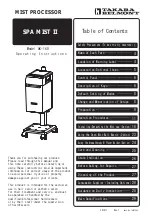
after 5 minutes of vacancy): The load turns ON and OFF automatically based on
occupancy detection. Once turned ON the RH-250 keeps the load ON until no
motion is detected by any of the related RH-250s for the time delay period. If
the load is turned OFF manually, automatic-ON is re-enabled when no motion is
detected for 5 minutes. This prevents the load from being turned ON after it was
deliberately turned OFF.
Time Delay
The time delay can be selected by the user during set up. It can be adjusted
to any of these fixed values:15 seconds/5 minutes/15 minutes/30 minutes. We
recommend that the time delay be the same in all sensors related to the same
load. This makes it easier to understand the multi-way control operation as well
as trouble shooting. For additional information on how to adjust it, please read the
SENSOR ADJUSTMENT & PROGRAMMING section of this installation manual.
Light Level
When the operating mode is set for occupancy sensor, Mode 2 (Auto-ON) this
feature prevents the sensor from automatically turning the lights ON if there is
already enough light in the area.
In a multi-way application, each sensor monitors the light level at it’s location.
If any sensor related to the load detects motion AND the measured light level in
that sensor’s area is lower than it’s Light Level setting, the load turns ON.
To adjust the light level, please read the SENSOR ADJUSTMENT &
PROGRAMMING section of this installation manual.
Coverage Area
The RH-250 has a maximum coverage range
of 180 degrees and a coverage area of 600
square feet (56 square meters). The sensor
must have a clear and unobstructed view
of the coverage area. Objects blocking the
sensor’s lens may prevent detection thereby
causing the light to turn OFF even though
someone is in the area.
Windows, glass doors, and other
transparent barriers will obstruct the
sensor’s view and prevent detection.
INSTALLATION & WIRING
These instructions describe only the 3-way circuit applications. For information
about other applications, consult technical support.
WARNING
Disconnect power to the wall switch box by turning OFF
the circuit breaker or removing the fuse for the circuit before
installing the RH-250, replacing lamps, or doing any electrical work.
1. Prepare the switch box.
After the power is turned OFF at the circuit breaker box, remove the existing
wall plate and mounting screws. Pull the old switch out from the wall box.
2. Identify the type of circuit.
You may connect the RH-250 to a single pole or multi-way circuit. If you are
unable to clearly identify some or all of the wires mentioned in this manual,
you should consult with a qualified electrician.
In a 3-way circuit (see Fig. 2), two traveler wires connect to both switches.
Another wire provides power from the circuit box to one of the switches. A wire
connects from one switch to the load. A ground wire may also be connected to
a ground terminal on the old switches. A neutral wire should also be present in
both wall boxes.
NEUTRAL
GROUND
LOAD/Common
(power to lamp)
NEUTRAL
GROUND
HOT/Common
(power from circuit box)
TRAVELER
TRAVELER
Lamp/load
MASTER SWITCH
AUXILIARY SWITCH
Fig. 2: Typical 3-Way Switch Wiring
www.wattstopper.com
25'
(7.6m)
12'
(3.7m)
Fig. 1: Sensor Coverage Area





























